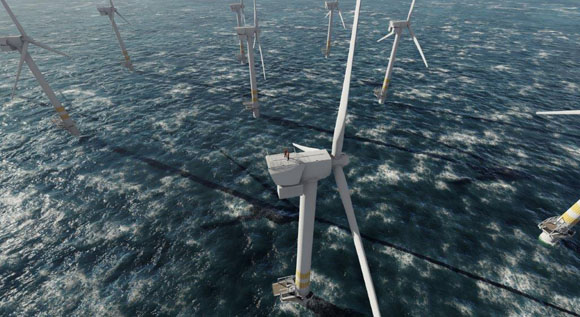„European power stations”
Denmark, the Netherlands, Belgium and Germany want to speed up the expansion of wind energy in the North Sea, harness new potential for green hydrogen and develop joint „energy islands”.
 © Adobe Stock / dragancfm
© Adobe Stock / dragancfm
These aims are set forth in a declaration signed at the North Sea Summit in Esbjerg (Denmark) on 18 May. The Heads of State and Government and the Energy Ministers of Germany, Denmark, the Netherlands and Belgium were joined at the meeting by European Commission President Ursula von der Leyen und EU Energy Commissioner Kadri Simson. Business representatives from all participating countries also attended.
In the declaration, the participating countries agreed to develop joint „hybrid” offshore cooperation projects connecting wind farms with several states at once, thus forming „energy islands” in the sea. The aim is for the North Sea to emerge as a „Green Power Plant of Europe” and to supply the EU with green electricity.
Minister Robert Habeck said: „The agreement reached by the Energy Ministers today is an important milestone in cross-border cooperation. It is the basis for the first genuinely European power plants – and, what’s more, they will be producing electricity from renewable energy. Working with our partners, we can expand offshore wind energy in the North Sea even more quickly and efficiently and open up new potential for green hydrogen. In this way we are consolidating the expansion of renewables in Europe and thus further reducing our dependence on gas imports.” (To read how an offshore wind farm actually works, click here (German only).)
Generation capacities in the North Sea could grow tenfold by 2050
Together the four countries set themselves the target of expanding generation capacities for offshore wind energy in the North Sea by at least 65 gigawatts (GW) by 2030 and 150 gigawatts (GW) by 2050. This would mean increasing today’s generation capacity fourfold by 2030 and tenfold by 2050. Other goals agreed include electricity market rules at EU level that enable electricity generated from wind energy to be effectively integrated into the grid, and a fair cost-benefit split in cooperation projects among the participating countries. Participants in the summit in Esbjerg also discussed the importance of financing instruments and the acceleration of approval procedures at EU level.
At the same time, cooperation on the future production of green hydrogen from offshore wind energy and on the development of the hydrogen infrastructure in the region is to be stepped up. Federal Minister Habeck and Danish Energy Minister Dan Jørgensen also agreed to work closely together on green hydrogen and on the development of cross-border infrastructure. Read the Letter of Intent with Denmark here.
Further information
- Press release by the Federal Ministry for Economic Affairs and Climate Action: „Energy Ministers of the four North Sea littoral states sign agreement on cooperation on offshore wind energy and green hydrogen“ (German only)
- The Declaration of Energy Ministers on The North Sea as a Green Power Plant of Europe (PDF download, 708 KB)

